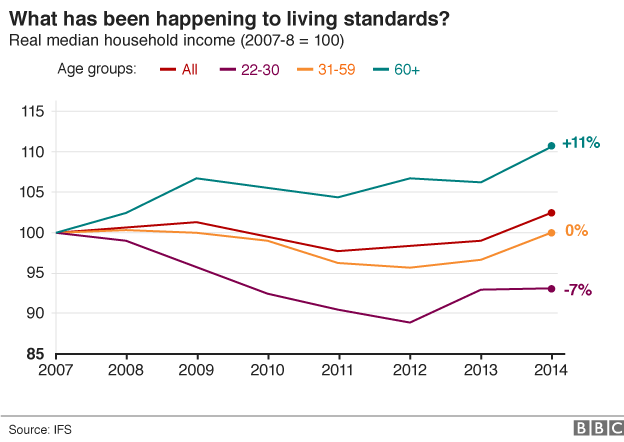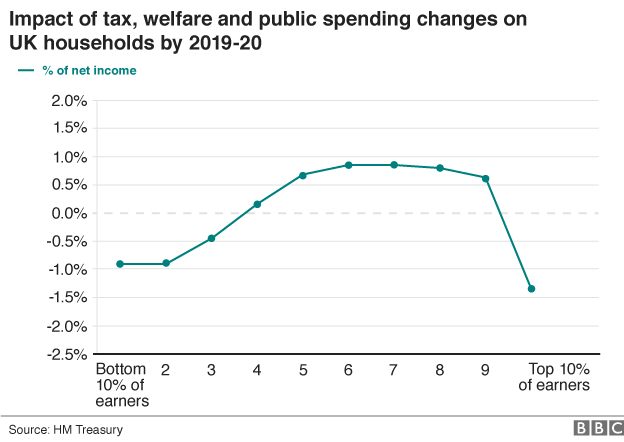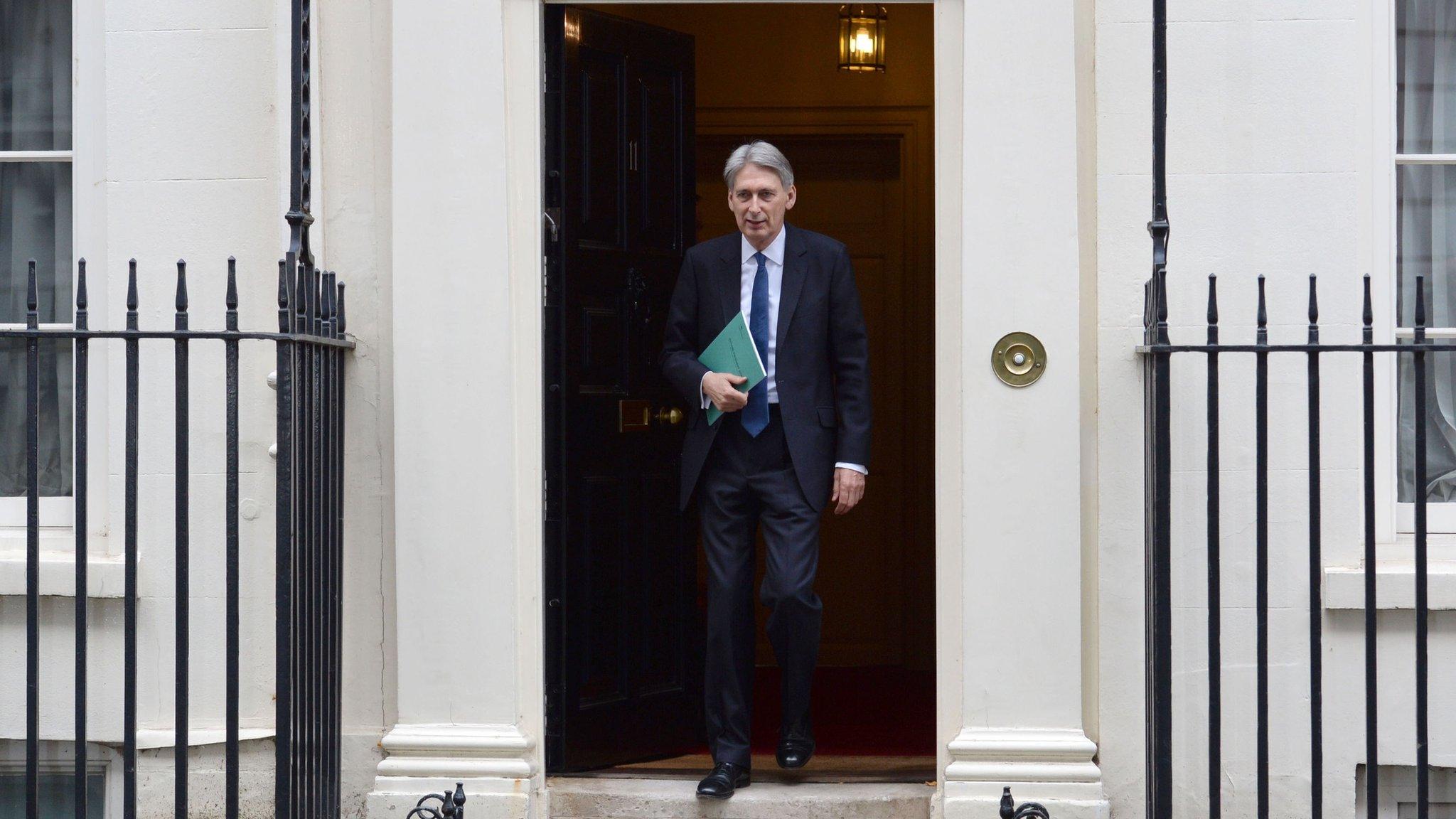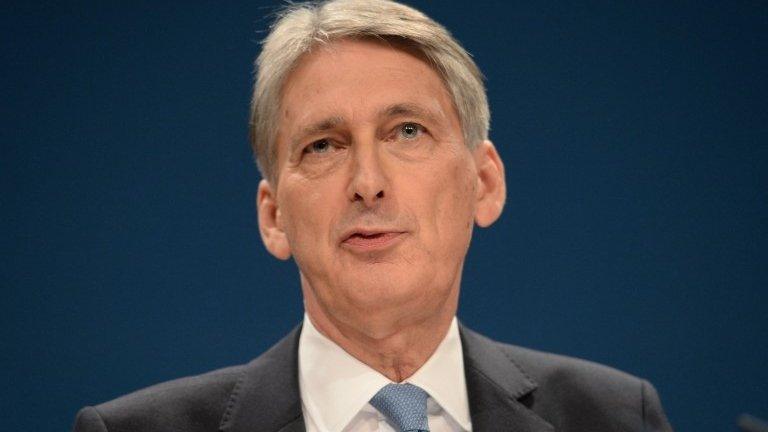Autumn Statement: Workers' pay growth prospects dreadful, says IFS
- Published
"Worst decade for [growth in] living standards," says IFS chief
The outlook for wages is "dreadful" with the squeeze on pay lasting for more than 10 years, independent economists have said.
The Institute for Fiscal Studies (IFS) said workers would earn less in real wages in 2021 than they did in 2008.
Other analysis shows the biggest losers between now and 2020 will be lower income families, with the poorest third likely to see incomes drop.
Chancellor Philip Hammond said millions of new jobs had been created.
Defending his Autumn Statement plans, the chancellor told Radio 4's Today programme that the government had brought job growth. It was investing for the future, preparing for a "rainy day", and government borrowing was on a "downward path", he added.
In its analysis of the Autumn Statement, the independent think tank, the IFS, said workers would earn less in real wages in 2021 than they did in 2008.
"This has, for sure, been the worst decade for living standards certainly since the last war and probably since the 1920s," said Paul Johnson, director of the IFS.
"We have seen no increase in average incomes so far and it does not look like we are going to get much of an increase over the next four or five years either."
The "outlook for living standards and for the public finances has deteriorated pretty sharply over the last nine months", he added.

Real average earnings - which factor in the rising cost of living - were forecast to rise by less than 5% between now and 2021. That forecast is 3.7% lower than was projected in March.
"Half of the wage growth projected for the next five years back in March is not now projected to happen. On these projections real wages will, remarkably, still be below their 2008 levels in 2021," Mr Johnson said.
"One cannot stress enough how dreadful that is - more than a decade without real earnings growth. We have certainly not seen a period remotely like it in the last 70 years."
The biggest impact on income in recent years, according to the IFS, has been felt by younger workers. Those aged 60 and over, in contrast, have seen living standards rise.

The squeeze on living standards could be worse during this Parliament than between 2010 and 2015, suggests the Resolution Foundation think tank. which campaigns for people on low and middle incomes.
Lower growth in pay, an accelerating rise in the cost of living, and welfare changes such as a freeze on working age benefits all combined to show that incomes on average would only grow by 0.2% a year, it said.
This compares to a rise of 0.5% during the coalition government years - a period of austerity in the aftermath of the financial crisis.
"Taking all this together we can look at the outlook for family incomes in the coming years, and it paints a grim picture," the think tank said.
Philip Hammond tells Radio 4's Today programme there is uncertainty about the forecasts
Significantly, given the government's focus on "just about managing" families, the data shows that lower income families will be worse off.
The Foundation said the poorest 10% would see an income hit of more than 3% by 2020 as a result of tax and welfare policies.
"While top earners were hit the hardest following the financial crisis, the big difference looking forward is that the biggest losers are lower income families, with the entire bottom third of the income distribution set to see incomes fall in the years ahead," the Foundation said.
The Treasury's own analysis, external, published alongside the Autumn Statement, shows that the poorest 30% of households will see a negative impact on incomes from tax, welfare and public spending measures by 2019-20.

Primarily, this is a result of the main working age benefits and tax credits being frozen in cash terms for four years from April 2016. That includes entitlements such as jobseeker's allowance and income support.
That income freeze is forecast to coincide with an acceleration in inflation, pushing up the cost of living.
The chancellor offered some help to the lowest paid with changes to Universal Credit - the new umbrella benefit gradually being introduced across the UK.
Mr Hammond announced a reduction in the rate at which the benefit is withdrawn from people when they start work.
The Resolution Foundation report, external said this would have relatively little impact on family finances.
"When set against all other policy changes announced since the 2015 election, the Autumn Statement only undoes 7% of the hit from benefit cuts to the bottom half of the income distribution," it said.
Middle-income families will see some rises in income, but by no more than 1%, the Treasury documents show. The richest 10% will see the biggest hit to incomes.
Shadow Chancellor John McDonnell tells Radio 4's Today Labour would tax differently
More broadly, the IFS said that the OBR had forecast that national income in 2020-21 would be £30bn lower than projected in March - the equivalent to £1,000 per household.
Among Mr Hammond's announcements were:
Reducing the rate at which benefits are withdrawn from people when they start work
A rise in insurance premium tax which is expected to increase the cost of policies
Increasing the National Living Wage to £7.50 an hour from April 2017
New spending on housing projects totalling £3.7bn in England
Cancelling the fuel duty increase for the seventh year running
£60m a year for grammar school expansion
The IFS said that Mr Hammond had clearly put whatever money he had into long-term plans.
"The clear prioritisation by Mr Hammond to direct most of what largesse he felt able to afford to paying for additional investment spending - roads, housing, research and development - to support the economy in the long run, rather than to pay to support the incomes of the "just-about-managing", or indeed public services, in the short run," Mr Johnson said.

What questions do you have about the Autumn Statement?
If you are reading this page on the BBC News app, you will need to visit the mobile version of the BBC website to submit your question.
- Published24 November 2016

- Published23 November 2016

- Published23 November 2016

- Published24 November 2016
- Published23 November 2016